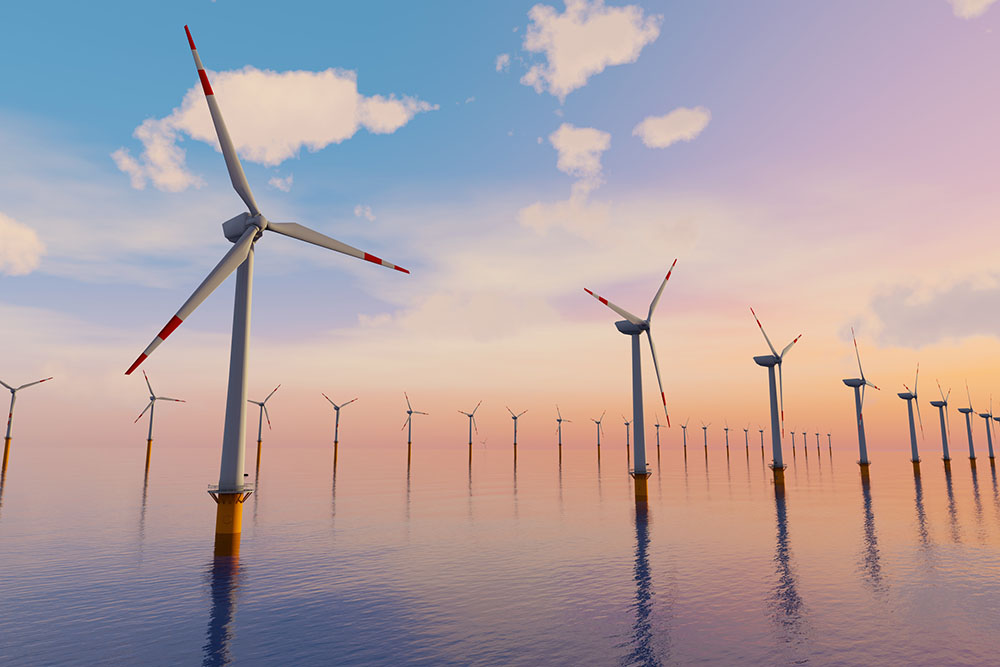Wind energy was first used to generate electricity in July 1887 by Prof James Blyth, who created the first turbine. In recent decades, wind power has become a huge industry – now comprising 29.4% of the UK’s total electricity generation. It is an area of exciting innovation including “airborne” turbines and “wind harvesters” (which can harness low-speed winds). This industry report outlines the start of wind power in 2024. We identify major trends, key players, rising stars, risks and opportunities for investors as they consider renewable investment opportunities for their portfolios.
Market Overview: wind power
The global wind energy industry was estimated at USD 80.42 billion in 2022 and is projected to expand further. In 2023, it was valued at USD 87.66 billion and could reach USD 174.66 billion by 2031, representing a compound annual growth rate (CAGR) of 9%. Indeed, the industry hit a record-high last year (2023) at 117 gigawatts (GW) of new capacity—50% higher than in 2022!
This growth trend is not simply confined to developed economies in the West. Rather, it covers 54 countries across all continents. Yet the stage is still set for continuing global demand. The Global Wind Energy Council (GWEC)’s Global Wind Report 2024 insists that onshore wind capacity must surpass its 100GW yearly record by three times to achieve global net zero emissions by 2050. This will require 320GW of new capacity to be installed every year by 2030.
Key Features, benefits and trends
Wind power offers a range of advantages to individuals, societies and governments. For the latter, it offers a means of increased energy security in a world of volatile commodity prices. The War in Ukraine has been detrimental to local people. Yet, the constrained supply of oil and agricultural produce to the rest of the world also pushed up prices (e.g. for petrol) in the UK and elsewhere, driving up inflation and eroding household real disposable income.
The UK, in particular, is well-positioned for a wind power revolution. Due to its geography, long coastline and shallow waters as an island nation, our country is widely considered “the best” in Europe for wind power investment. However, even larger nations are stepping up wind power production. China recently set a new record of 75GW of new installations. The US, Brazil, Germany and India are also considered the top global markets for wind power.
Energy security is not the only driving factor in politics. Last year, at the UN’s climate summit hosted in Dubai, over 100 countries signed their commitment to keep the Paris Agreement going (i.e. to keep global temperature rises below 1.5 degrees Celsius). Many of these nations are democracies which will face voters regularly at elections who will likely wish to see progress on this commitment.
Key players and new entrants
In the UK, the wind power market is highly consolidated. One to five major players, including Orsted, Vattenfall, Vestas Wind Systems, and Siemens Gamesa Renewable Energy, dominate the industry. However, considerable space remains in the market for startups to excel.
KiteKraft, for instance, is pioneering the design of flying wind turbines to produce electrical energy and electricity generation at a low cost. The company claims that these wind turbines use 10x less material than land-based turbines, are low cost and “almost invisible”. Crucially, airborne solutions help to overcome a longtime major hurdle to wind power adoption – i.e. bringing power generation closer to consumers.
Another interesting case study is Perceptual Robotics. Based in Bristol, this company uses intelligent automation to simplify inspecting wind turbines. Using AI and scalable cloud systems, Perceptual Robotics enables firms and governments to inspect even the largest turbines in minutes, facilitating predictive analysis and offering considerable cost savings.
Risks & opportunities
The UK’s wind sector offers a range of attractive tailwinds in 2024 (excuse the metaphor!). The government has committed to reaching net-zero emissions by 2050, which is likely to be adopted by future administrations. A high number of wind energy projects are already in the pipeline, especially in the offshore segment.
Yet, there are hurdles which cannot be overlooked. Planning permission for turbines remains difficult in many areas of the UK, especially where “Nimby Wars” are fierce. Wind power also continues to compete with alternative renewable energy sources – e.g. solar and hydropower. Wind farms may be limited to rural areas, such as farms in remote locations, which makes it difficult to build a robust electricity system which can supply urban areas.
Wind farms are expensive to set up and rely on the wind to blow. Breeze fluctuations make it difficult to guarantee a non-interrupted energy supply to consumers. However, there are encouraging signs that innovation can overcome many of these hurdles. Just as technological strides have made wind turbine construction cheaper to build and more reliable, further advances hold great promise for “nature-based” barriers to mass adoption (e.g. geographical proximity and breeze).
“Bladeless” wind power and “wind turbine lenses” technologies are good examples, offering up to threefold turbine efficiencies. “Vertical axis turbines” could also overcome many planning restrictions from local authorities. For instance, the Windspire model is 30 feet tall and 4 feet wide, enabling it to overcome the 35-foot height restriction in some municipalities.
Invitation
If you are interested in expanding your portfolio into these kinds of exciting spheres of investing, then we invite you to get in touch with us here at Bure Valley and consider joining our exclusive investor network:
+44 160 334 0827


